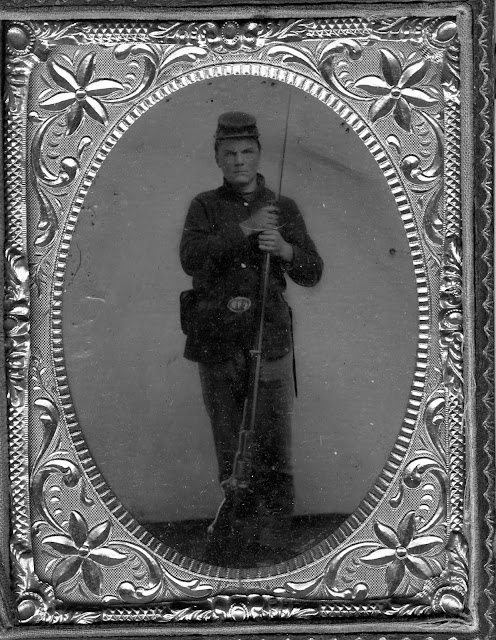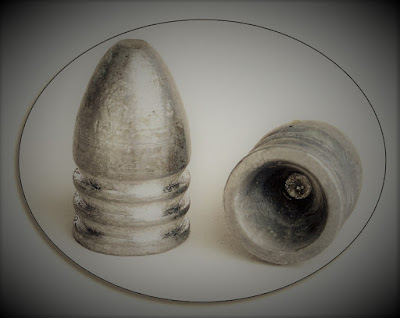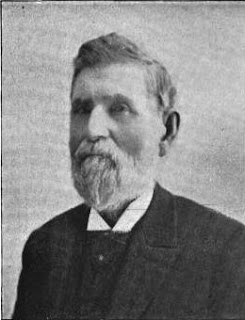Indexing the Gallipolis Journal
I was thinking of just calling this blog post "Oh, the joys of indexing," but I figured that would probably elicit a collective yawn from much of my usual visitors although in all honesty, the blog post will share a bit of the joys I find from the slow painstaking work of constructing an index to the Civil War era correspondence in a newspaper. From the number of posts on this blog, you've already enjoyed the fruits of the indexing work- incredible accounts of the Civil War written by Ohioans. Now you can see a bit of how I discover these gems...
Today, I finished going through the wartime issues of the Gallipolis Journal, a Republican newspaper in Gallia County that was a consistent supporter of the Union war effort. Located along the bustling Ohio River, Gallipolis was on the front lines of the war in the early days as western Virginia lay just across the river.
One of the things that I most enjoy about putting an index together is that when you look at a series of newspapers, you really don't know what surprises reside within; it's the pure unalloyed joy of discovery when you come across something that fills a void in your knowledge, or answers that long-held question, or just makes you say wow. Its essentially a gift box waiting for you to open it- every once in a while, that gift box becomes a bit of a dud, other times, you are left shaking your head at how much great material you uncover as you sift through issue after issue. Last weekend, I shared the story of Lieutenant William H. Raynor of the 1st O.V.M., his experiences at First Bull Run, then subsequent imprisonment and escape from the Confederates. (see http://dan-masters-civil-war.blogspot.com/2018/06/at-first-bull-run-with-first-ovm.html) which I uncovered while putting this index together.
The process for doing these indexes is straightforward- start reading the issues closest to the firing upon Fort Sumter (April 12, 1861), and then document each letter (or really interesting article) that you uncover as you work your way towards Appomattox. The letters will often have the author's name at the top or bottom of the piece, and it may take some investigative work to figure out who that author was- perhaps scanning through a regimental roster, etc. I have run into instances where I can figure out the author (signed their name as just an "H." or an "N."), but figure it out later in when a subsequent letter that has their name references their previous letter. I try to note the soldiers name, company and regiment- once you have these three pieces of data, you can start putting the letter into context within a broader narrative.
You'll see some standard patterns which really mirror the story of the war for that community- the early war time enthusiasm which manifests itself in a flood of letters describing all the exciting action (or lack thereof) on the periphery of Virginia. The frustration of the defeat at First Bull Run gives way to a heady determination to get serious about winning the war- the flush of Union victories in the spring of 1862 which gives way to the horrors of lengthy casualty lists and a series of Union setbacks in the fall and winter of 1862. In the spring of 1863, war weariness gripped the North and you'll see a dichotomy- Republican papers loaded with letters from soldiers at the front encouraging the home folks to stand behind them and not give into "Copperheadism," while Democratic papers will gleefully publish soldiers' letters giving voice to the poor morale of the men, and lampooning some of the generals who lead them.
The summer of 1863 is marked by the dual excitements of Gettysburg and John Morgan's raid through Ohio, and gives way to the Ohio gubernatorial campaign of 1863 in which John Brough handily defeated the icon of the Copperheads, Clement L. Vallandigham. Union victories at Chattanooga in November 1863 presage a quiet winter in which hundreds of thousands of Union soldiers re-enlist for three more years, determined to "see the thing through." The spring of 1864 dawns with hope that under new leadership (Grant in the East, Sherman in the West), the war can be successfully brought to a conclusion. It was a tough summer that saw the calling up of the Ohio National Guards, another Confederate invasion of the North (Early's campaign), lengthy casualty lists from the Army of the Potomac and Sherman's force, and the nomination of "Little Mac" to run against Lincoln in the presidential election.
Fall dawns with Union victories at Atlanta, then a series of triumphs by Sheridan in the Shenandoah Valley which helps Lincoln secure victory at the ballot box. In many papers, the volume of soldiers' letters drops off significantly after Lincoln's victory, but you can usually find (in Ohio papers anyway) some nice accounts of Franklin and Nashville, or the March to the Sea, but the winter of 1865 will be fairly quiet, and the campaign season barely gets underway in April 1865 before Lee's surrender at Appomattox, and then Johnston's surrender at the end of April which virtually ends all combat.
Along the way, you hear from dozens of men from a multitude of units- the Gallipolis Journal had quite a collection of letters from soldiers in the 18th OVI, 33rd OVI, 36th OVI, 56th OVI, 91st OVI, 7th OVC, 18th Ohio Battery, as well as scattered letters from soldiers serving in out of state regiments such as West Virginia and Pennsylvania. Along the way we read about the battles of First Bull Run, Fort Donelson, Shiloh, Lewisburg, Fair Oaks, Cross Keys, the Seven Days, Antietam, Stones River, Champion's Hill, Chickamauga, Missionary Ridge, Sabine Crossroads, Snicker's Gap, Cedar Creek, and more. Their stories of the combat that engulfed the country, the triumphs and defeats, and their sacrifices make for scintillating reading- I never tire of reading of letters. It is a fascinating window into the Civil War experience and the learning never stops...
Gallipolis was home to an army depot and hospital, and had a small garrison throughout the war which sometimes caused problems with the local townsfolk as drunkenness and fighting became common occurrences. (The town had over 100 drinking holes by the summer of 1863). Some units that served here gained the townspeople's general acclimation (the 37th Iowa for instance) while others (the 192nd Pennsylvania in particular), the citizens could hardly wait for them to leave.
The index is now posted online on my Columbian Arsenal Press website- please feel free to download the Excel file and then visit Chronicling America (link below) to read for yourself some of the incredible accounts documented in the index. Enjoy!
Columbian Arsenal Press: https://columbianarsenal.com/newspaper-indexes
Chronicling America: Gallipolis Journal: https://chroniclingamerica.loc.gov/lccn/sn85038121/
Today, I finished going through the wartime issues of the Gallipolis Journal, a Republican newspaper in Gallia County that was a consistent supporter of the Union war effort. Located along the bustling Ohio River, Gallipolis was on the front lines of the war in the early days as western Virginia lay just across the river.
One of the things that I most enjoy about putting an index together is that when you look at a series of newspapers, you really don't know what surprises reside within; it's the pure unalloyed joy of discovery when you come across something that fills a void in your knowledge, or answers that long-held question, or just makes you say wow. Its essentially a gift box waiting for you to open it- every once in a while, that gift box becomes a bit of a dud, other times, you are left shaking your head at how much great material you uncover as you sift through issue after issue. Last weekend, I shared the story of Lieutenant William H. Raynor of the 1st O.V.M., his experiences at First Bull Run, then subsequent imprisonment and escape from the Confederates. (see http://dan-masters-civil-war.blogspot.com/2018/06/at-first-bull-run-with-first-ovm.html) which I uncovered while putting this index together.
The process for doing these indexes is straightforward- start reading the issues closest to the firing upon Fort Sumter (April 12, 1861), and then document each letter (or really interesting article) that you uncover as you work your way towards Appomattox. The letters will often have the author's name at the top or bottom of the piece, and it may take some investigative work to figure out who that author was- perhaps scanning through a regimental roster, etc. I have run into instances where I can figure out the author (signed their name as just an "H." or an "N."), but figure it out later in when a subsequent letter that has their name references their previous letter. I try to note the soldiers name, company and regiment- once you have these three pieces of data, you can start putting the letter into context within a broader narrative.
You'll see some standard patterns which really mirror the story of the war for that community- the early war time enthusiasm which manifests itself in a flood of letters describing all the exciting action (or lack thereof) on the periphery of Virginia. The frustration of the defeat at First Bull Run gives way to a heady determination to get serious about winning the war- the flush of Union victories in the spring of 1862 which gives way to the horrors of lengthy casualty lists and a series of Union setbacks in the fall and winter of 1862. In the spring of 1863, war weariness gripped the North and you'll see a dichotomy- Republican papers loaded with letters from soldiers at the front encouraging the home folks to stand behind them and not give into "Copperheadism," while Democratic papers will gleefully publish soldiers' letters giving voice to the poor morale of the men, and lampooning some of the generals who lead them.
The summer of 1863 is marked by the dual excitements of Gettysburg and John Morgan's raid through Ohio, and gives way to the Ohio gubernatorial campaign of 1863 in which John Brough handily defeated the icon of the Copperheads, Clement L. Vallandigham. Union victories at Chattanooga in November 1863 presage a quiet winter in which hundreds of thousands of Union soldiers re-enlist for three more years, determined to "see the thing through." The spring of 1864 dawns with hope that under new leadership (Grant in the East, Sherman in the West), the war can be successfully brought to a conclusion. It was a tough summer that saw the calling up of the Ohio National Guards, another Confederate invasion of the North (Early's campaign), lengthy casualty lists from the Army of the Potomac and Sherman's force, and the nomination of "Little Mac" to run against Lincoln in the presidential election.
 |
| The Gallipolis Journal was delighted at the re-election of Abraham Lincoln in November 1864 and the above broadside spread across much of page 2. "The Rail Splitter Triumphant!" |
Fall dawns with Union victories at Atlanta, then a series of triumphs by Sheridan in the Shenandoah Valley which helps Lincoln secure victory at the ballot box. In many papers, the volume of soldiers' letters drops off significantly after Lincoln's victory, but you can usually find (in Ohio papers anyway) some nice accounts of Franklin and Nashville, or the March to the Sea, but the winter of 1865 will be fairly quiet, and the campaign season barely gets underway in April 1865 before Lee's surrender at Appomattox, and then Johnston's surrender at the end of April which virtually ends all combat.
 |
| Recruiting advertisement for the 4th Ohio Volunteer Cavalry from January 1864. |
Gallipolis was home to an army depot and hospital, and had a small garrison throughout the war which sometimes caused problems with the local townsfolk as drunkenness and fighting became common occurrences. (The town had over 100 drinking holes by the summer of 1863). Some units that served here gained the townspeople's general acclimation (the 37th Iowa for instance) while others (the 192nd Pennsylvania in particular), the citizens could hardly wait for them to leave.
The index is now posted online on my Columbian Arsenal Press website- please feel free to download the Excel file and then visit Chronicling America (link below) to read for yourself some of the incredible accounts documented in the index. Enjoy!
Columbian Arsenal Press: https://columbianarsenal.com/newspaper-indexes
Chronicling America: Gallipolis Journal: https://chroniclingamerica.loc.gov/lccn/sn85038121/
 |
| Recruiting advertisement for the 56th Ohio Volunteer Infantry- the recruits soon saw hard service in Banks' disastrous Red River campaign. |









Comments
Post a Comment